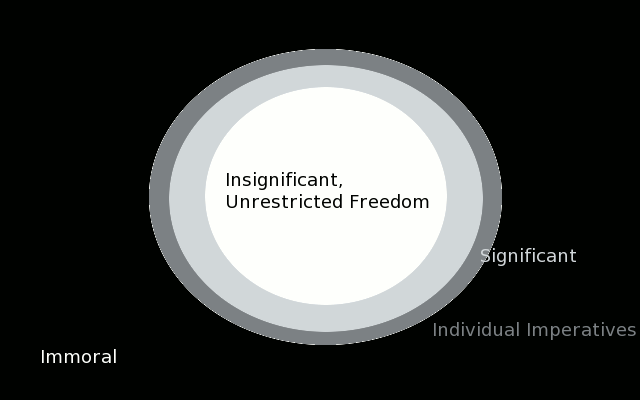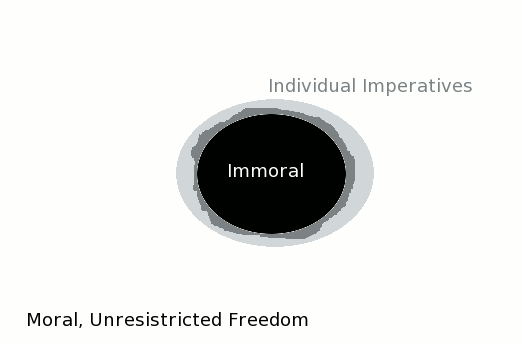Decision Making
April 2009
I've found that when it comes to describing how to make decisions from a theistic perspective, the illustrations used can be very helpful but also misleading. I seek to show a preferable model.
The theistic perspective assumes that our decision making should not only be concerned with what we desire, but also with what God's will for us may be. In theism God is assumed to be good and knowledgeable, so His will is ultimately more beneficial for us than ours (given our corrupt and limited perspective).
The bible clearly outlines many areas of immorality, things that are explicitly not in God's will (represented in black). It is wrong to make immoral decisions so this can help us decide in a lot of cases. However, there are also categories within the "moral" realm that could be part of God's will or not. Certain individual imperatives (dark gray) could be wrong for some people even though not wrong for all people. Two examples are having an alcoholic drink (for an alcoholic) or watching a middle school swim practice (for a pedophile). While having a drink or watching a practice is not normally wrong, it could be very foolish for people who have specific difficulties in those areas. Other areas are significant but non-moral (light gray). They will end up affecting much of one's life but they are not explicitly commented on in scripture nor are they "right" or "wrong". Where to live, who to marry, and what career to pursue are often in this category. They will affect many of the other things you try to do but there are several options you could chose. One can live a variety of places and follow God. One can be in a variety of careers and do so well. All other decisions are non-moral and insignificant (white). What socks to wear, what to eat for lunch, or how to arrange your bookshelf are all examples of insignificant decisions. We have freedom in this area to do as we please.
The Common Model

This model is given by showing the limits that our decision making should operate within. While it shows the different categories in an understandable way, I believe that its emphasis is off. It seems to imply an ever increasing restriction on our decision making by God. The Great Taskmaster cracking his whip. Instead I propose the following.
The Sin Gravity Model

As opposed to implying God's restrictive nature, it is more accurate to emphasize sin's destructive pull (Romans 7:11,15, Genesis 4:7). In this model, immorality is what our hearts are drawn to and sin is a terrible trap that our decision making gets stuck in. The individual imperatives (dark gray) are dangerous for us because they are areas that so often pull us right back into the immoral. Outside of that is the area of non-moral but significant (light gray). These are areas that are major enough to affect our options to do well or influence us over time back towards the middle. Living in a place where you are likely to be able to love and serve is more likely to push you outwards towards the moral than a place of autonomous comfort, which may influence you back towards the immoral. Outside of this is the tremendous freedom God gives us (John 8:32). God wants us to use all of our creativity, skills, and strengths to do good and help others (Hebrews 10:24). Instead of having complete freedom in insignificant things, many of these decisions are very significant. They can affect others as well as ourselves to many glorious ends.